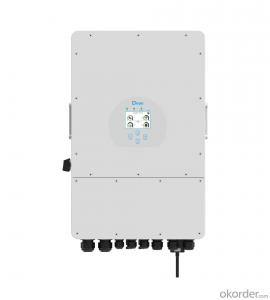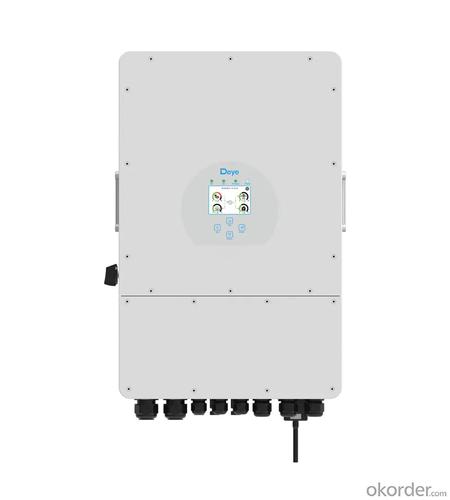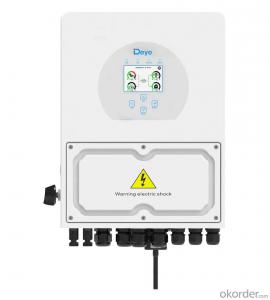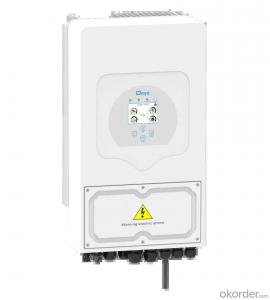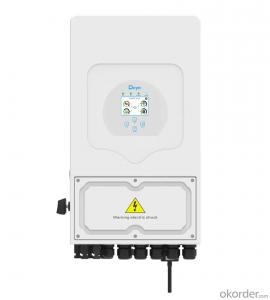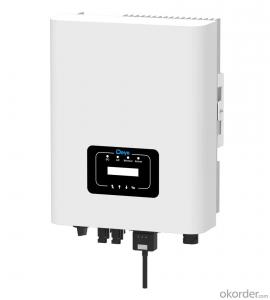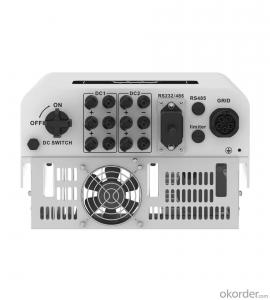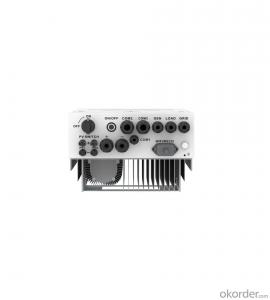Nep Solar Inverter - Sun-5/6/8/10/12k-SG04LP3 Hybrid Inverter Low Voltage Battery Higher Yields
- Loading Port:
- Ningbo
- Payment Terms:
- TT OR LC
- Min Order Qty:
- 100 pc
- Supply Capability:
- 5000 pc/month
OKorder Service Pledge
OKorder Financial Service
You Might Also Like
Specification
Higher yields / Safe & Reliable / Smart / User-friendly
SUN 5/6/8/10/12K-SG is brand new three phase hybrid inverter with low battery voltage 48V, ensuring system safe and reliable. With compact design and high-power density, this series supports 1.3 DC/AC ratio, saving device investment. It supports three phase unbalanced output, extending the application scenarios. Equipped with CAN port (x2) BMS and parallel, x1 RS485 port for BMS, x1 RS232 port for remotely control, x1 DRM port, which makes the system smart and flexible.
100% unbalanced output, each phase; Max. output up to 50% rated power
DC couple and AC couple to retrofifit existing solar system
Max. 16pcs parallel for on-grid and offff-grid operation; Support multiple batteries parallel
Max. charging/discharging current of 240A
48V low voltage battery, transformer isolation design
6 time periods for battery charging/discharging
Support storing energy from diesel generator
| Technical Data | |||||||
| Model | SUN-5K -SG04LP3-EU | SUN-6K -SG04LP3-EU | SUN-8K -SG04LP3-EU | SUN-10K -SG04LP3-EU | SUN-12K -SG04LP3-EU | ||
| Battery Input Data | |||||||
| Battery Type | Lead-acid or Li-lon | ||||||
| Battery Voltage Range (V) | 40~60 | ||||||
| Max. Charging Current (A) | 120 | 150 | 190 | 210 | 240 | ||
| Max. Discharging Current (A) | 120 | 150 | 190 | 210 | 240 | ||
| External Temperature Sensor | Yes | ||||||
| Charging Curve | 3 Stages / Equalization | ||||||
| Charging Strategy for Li-Ion Battery | Self-adaption to BMS | ||||||
| PV String Input Data | |||||||
| Max. DC Input Power (W) | 6500 | 7800 | 10400 | 13000 | 15600 | ||
| Rated PV Input Voltage (V) | 550 (160~800) | ||||||
| Start-up Voltage (V) | 160 | ||||||
| MPPT Voltage Range (V) | 200-650 | ||||||
| Full Load DC Voltage Range (V) | 350-650 | ||||||
| PV Input Current (A) | 13+13 | 26+13 | |||||
| Max. PV ISC (A) | 17+17 | 34+17 | |||||
| Number of MPPT / Strings per MPPT | 2/1+1 | 2/2+1 | |||||
| AC Output Data | |||||||
| Rated AC Output and UPS Power (W) | 5000 | 6000 | 8000 | 10000 | 12000 | ||
| Max. AC Output Power (W) | 5500 | 6600 | 8800 | 11000 | 13200 | ||
| AC Output Rated Current (A) | 7.6 | 9.1 | 12.1 | 15.2 | 18.2 | ||
| Max. AC Current (A) | 11.4 | 13.6 | 18.2 | 22.7 | 27.3 | ||
| Max. Continuous AC Passthrough (A) | 45 | ||||||
| Peak Power (off grid) | 2 time of rated power, 10 S | ||||||
| Power Factor | 0.8 leading to 0.8 lagging | ||||||
| Output Frequency and Voltage | 50/60Hz; 3L/N/PE 220/380, 230/400Vac | ||||||
| Grid Type | Three Phase | ||||||
| DC injection current (mA) | THD<3% (Linear load<1.5%)< td=""> | ||||||
| Efficiency | |||||||
| Max. Efficiency | 97.60% | ||||||
| Euro Efficiency | 97.00% | ||||||
| MPPT Efficiency | 99.90% | ||||||
| Integrated | PV Input Lightning Protection, Anti-islanding Protection, PV String Input Reverse Polarity Protection, Insulation Resistor Detection, Residual Current Monitoring Unit, Output Over Current Protection, Output Shorted Protection, Surge protection | ||||||
| Output Over Voltage Protection | DC Type II/AC Type III | ||||||
| Certifications and Standards | |||||||
| Grid Regulation | CEI 0-21, VDE-AR-N 4105, NRS 097, IEC 62116, IEC 61727, G99, G98, VDE 0126-1-1, RD 1699, C10-11 | ||||||
| Safety EMC / Standard | IEC/EN 61000-6-1/2/3/4, IEC/EN 62109-1, IEC/EN 62109-2 | ||||||
| General Data | |||||||
| Operating Temperature Range (℃) | -45~60℃, >45℃ derating | ||||||
| Cooling | Smrat cooling | ||||||
| Noise (dB) | <45 dB | ||||||
| Communication with BMS | RS485; CAN | ||||||
| Weight (kg) | 33.6 | ||||||
| Size (mm) | 422W x 699.3H x279D IP65 | ||||||
| Protection Degree | IP65 | ||||||
| Installation Style | Wall-mounted | ||||||
| Warranty | 5 years | ||||||
- Q: How does a solar inverter handle islanding detection?
- A solar inverter handles islanding detection by constantly monitoring the electrical grid. If it detects that the grid has been disconnected, it initiates a process to disconnect itself from the grid to prevent an islanding event. This is typically done through the use of advanced algorithms and protective mechanisms to ensure the safety and stability of the electrical system.
- Q: Can a solar inverter be used with dual MPPT inputs?
- Yes, a solar inverter can be used with dual MPPT inputs. Dual MPPT (Maximum Power Point Tracking) inputs allow the inverter to optimize the power output from two separate solar arrays or strings, thereby increasing overall energy efficiency and system performance.
- Q: What is the role of a solar inverter in power factor correction?
- The role of a solar inverter in power factor correction is to convert the direct current (DC) generated by the solar panels into alternating current (AC) that can be used by the electrical grid. In doing so, the solar inverter ensures that the AC power being fed into the grid has a power factor close to unity, which means it is efficient and does not cause any unnecessary strain on the electrical system. This helps to improve the overall power quality and efficiency of the solar energy system.
- Q: Three-phase photovoltaic inverter grid, the use of phase-locked loop is what?
- Grid-connected inverter can be operated locally through the LCD screen, or through remote monitoring with dedicated monitoring software.
- Q: Are solar inverters compatible with battery storage systems?
- Yes, solar inverters are compatible with battery storage systems. In fact, solar inverters play a crucial role in integrating battery storage with solar power systems. Solar inverters convert the direct current (DC) electricity generated by the solar panels into alternating current (AC) electricity that can be used to power our homes and businesses. Battery storage systems, on the other hand, store excess solar energy for later use, allowing us to use solar power even when the sun is not shining. When combined with solar inverters, battery storage systems can be charged using the excess energy generated by the solar panels during the day, and then discharge that stored energy during the night or during periods of high energy demand. To facilitate compatibility, solar inverters used in battery storage systems are equipped with additional features and functionalities. For example, they may have built-in charge controllers that regulate the charging and discharging of the batteries, ensuring their optimal performance and longevity. Additionally, advanced inverters may also include smart grid capabilities, allowing them to communicate with the utility grid and optimize energy flows based on grid conditions and electricity prices. Overall, solar inverters are essential components in ensuring the seamless integration of battery storage systems with solar power, enabling us to maximize the benefits of clean and sustainable energy.
- Q: Can a solar inverter be used with solar-powered electric vehicle charging stations?
- Yes, a solar inverter can be used with solar-powered electric vehicle charging stations. A solar inverter is necessary to convert the DC (direct current) power generated by solar panels into AC (alternating current) power that can be used by electric vehicle charging stations. This allows the solar power to be fed into the charging station and used to charge electric vehicles.
- Q: How long do solar inverters typically last?
- Solar inverters typically have a lifespan of around 10 to 15 years. However, the actual longevity can vary depending on factors such as the quality of the inverter, maintenance, and environmental conditions.
- Q: How does MPPT improve the efficiency of a solar inverter?
- MPPT (Maximum Power Point Tracking) improves the efficiency of a solar inverter by continuously adjusting the operating point of the solar panels to ensure they are producing maximum power. This is achieved by maximizing the voltage and current output of the panels, which allows the inverter to convert more of the available solar energy into usable electricity. By constantly tracking the maximum power point, MPPT ensures that the solar inverter operates at its highest efficiency, resulting in increased overall system efficiency and improved energy generation.
- Q: Can a solar inverter be used with solar-powered data centers?
- Yes, a solar inverter can be used with solar-powered data centers. A solar inverter converts the direct current (DC) produced by solar panels into alternating current (AC) that can be used to power electrical equipment, including data centers. By connecting the solar panels to a solar inverter, the generated solar energy can be effectively utilized to power data centers, making them more sustainable and reducing reliance on traditional power sources.
- Q: Can a solar inverter be used with solar-powered ventilation systems?
- Yes, a solar inverter can be used with solar-powered ventilation systems. The solar inverter is responsible for converting the direct current (DC) generated by the solar panels into alternating current (AC) that can be used to power various devices and systems, including ventilation systems. By connecting the solar panels to the solar inverter, the AC energy produced can be used to operate the ventilation system, making it an efficient and eco-friendly solution.
Send your message to us
Nep Solar Inverter - Sun-5/6/8/10/12k-SG04LP3 Hybrid Inverter Low Voltage Battery Higher Yields
- Loading Port:
- Ningbo
- Payment Terms:
- TT OR LC
- Min Order Qty:
- 100 pc
- Supply Capability:
- 5000 pc/month
OKorder Service Pledge
OKorder Financial Service
Similar products
Hot products
Hot Searches
Related keywords
